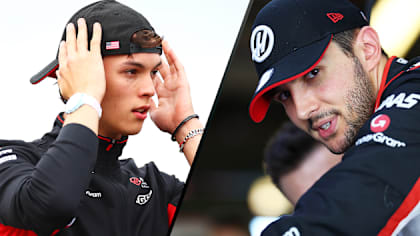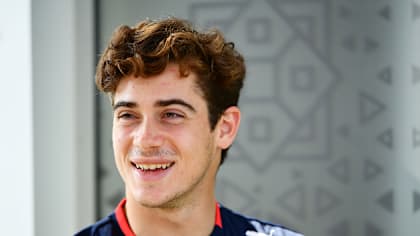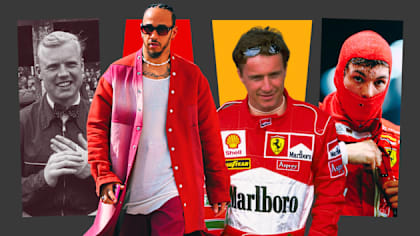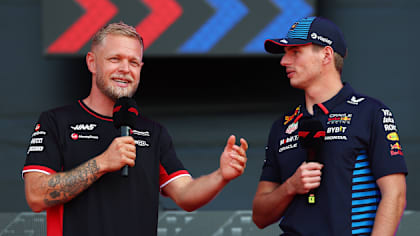In our series exploring the history of Grands Prix through selected iconic images, we turn our attention to Italy, and in particular to historic Monza.
This look back through the archives takes in a famous win for John Surtees, one of the closest finishes of all time, an emotional one-two for Ferrari, heartache for Mika Hakkinen, Sebastian Vettel’s stunning first win, and more…
Fangio takes dramatic, last-gasp win, Monza, 1953
Juan Manuel Fangio didn’t make mistakes very often, but a fatigue-induced error whilst competing in a non-championship race at Monza in 1952 nearly cost the legendary Argentine his life. After a lengthy period of recuperation the Maserati driver (number 50 in this picture) returned to action in 1953, only to suffer another hairy moment at the Italian venue when a rear tyre failure tipped him into a 220 km/h spin at Curva Grande during practice for that year’s Grand Prix. It’s a measure of the man that Fangio would not only return to the cockpit, but also go on to defeat the dominant Ferraris of Alberto Ascari (car 4) and Nino Farina (car 6) after an intense race-long battle. The order was only settled at the final corner of the last lap when Ascari spun out of the lead and was subsequently hit by Onofre Marimon’s Maserati (car 54), allowing Fangio, who had just passed Farina, to slip through for a psychologically-significant win.
(© LAT Photographic)
F1 racing bids farewell to Monza’s banking after tragedy, 1961
On four occasions between 1955 and 1961 the Italian Grand Prix was run on a perilously-quick 10-kilometre combined circuit, with Monza’s already rapid road course twinned with a high-speed banked oval. To say the layout didn’t meet with universal approval would be an understatement - the British teams boycotted the 1955 race and only agreed to take part in the ‘56 event after undertaking tests to ensure their cars could withstand the high speeds and bumpy surface. But F1 racing abandoned the banking for good following the tragic events which occurred during the 1961 race when championship-leader Wolfgang von Trips perished along with 13 spectators after his Ferrari tangled with Jim Clark’s Lotus on the run down to Parabolica and entered the crowd. This photo, taken during that race, shows the field entering Curva Nord, which began near to where the first chicane is now situated.
(© Sutton Images)
Surtees takes ‘Hondola’ to victory after incredible finale, Monza, 1967
With just one victory to their credit since their F1 arrival in 1964, Honda were persuaded to change tack in 1967, and on the advice of star driver John Surtees they enlisted British firm Lola to help build a new challenger, the RA300. The car, dubbed the ‘Hondola’ because of its mixed parentage, retained the same V12 engine as the Japanese manufacturer’s previous machine, the RA273, and arrived just in time for the 1967 Italian Grand Prix. Little was expected when Surtees could only qualify ninth, 1.8s down on Jim Clark’s pole time for Lotus, but in the race the 1964 world champion gradually climbed the order thanks to solid pace and the misfortune of others. Still, when Clark, who’d earlier lost a full lap because of a puncture, charged back into the lead seven laps from home, it seemed that the Scot was destined to claim an epic win. But fate had other ideas and as Clark went onto the final lap his Lotus 49 slowed with a fuel pump problem. Suddenly Surtees found himself in the lead, and despite the best efforts of Jack Brabham who threw his BT24 up the inside of the white Honda at Parabolica, the Briton held on to beat the Australian across the line by just 0.2 seconds. Honda were winners again, but it would be nearly 40 years before Jenson Button gave them their third victory as a fully-fledged manufacturer.
(© LAT Photographic)
Gethin wins - but only just! Monza, 1971
There have not been many occasions in the history of Formula One racing when five cars have gone into the final lap with a realistic shot at victory - but that’s exactly what happened in the ’71 race at Monza. Run on the Italian venue’s classic pre-chicane layout - a configuration that positively encouraged slipstreaming - the race featured eight different leaders and an astonishing 26 official lead changes, the last of which happened mere metres from the line. Tyrrell’s Francois Cevert (car 2) had his nose in front going into the final corner, but as the cars sprinted towards the chequered flag it was BRM’s Peter Gethin (white car, right of the picture) and March’s Ronnie Peterson (car 25) who’d pulled ahead, with the Brit eventually pipping the Swede by just 0.1s. Within 0.61s Cevert, Surtees’ Mike Hailwood (white car, partially obscured) and BRM’s Howden Ganley had all flashed across the line, completing the closest finish in the sport’s history and ensuring that Gethin’s one and only Grand Prix victory would never be forgotten.
(© LAT Photographic)
Brave Lauda makes sensational comeback, Monza, 1976
It’s one of the most astonishing stories in all of sport, not just Formula One racing - barely six weeks after being administered the last rites following his horrific Nurburgring smash, Niki Lauda was not only back on his feet, he was preparing to drive in the Italian Grand Prix. As this picture shows, the Austrian’s physical scars were still very raw when he arrived at Monza, but so too were the mental ones. Despite having returned to the cockpit at Fiorano prior to the weekend, Lauda found himself unable to drive in Friday’s practice session. “I was rigid with fear,” he’d later admit. But after an evening of soul searching and the admission that he was putting himself under too much pressure, the Ferrari star decided to try again - and the next day he qualified fifth, just 0.74s down on Jacques Laffite’s pole time, and quicker than team mates Carlos Reutemann and Clay Regazzoni. The following day, in another astonishing display of willpower, Lauda delighted the tifosi by coming home fourth in the race. "To virtually step out of the grave and six weeks later to come fourth in a Grand Prix is a truly amazing achievement,” said Lauda’s chief title rival James Hunt, who retired from the race in Italy. “He just got in the car and had a go, drove a typical Niki race: well-contained within himself and within the limitations of his fitness. He did a super, super job."
(© Sutton Images)
Andretti lifts tifosi with emotional comeback pole, Monza, 1982
1982 will undoubtedly go down as one of the worst seasons in Ferrari’s illustrious history. In the space of three months the Prancing Horse lost star driver Gilles Villeneuve to a fatal crash in Belgium and saw his championship-leading team mate Didier Pironi suffer what looked to be career-ending injuries in an horrific accident in Germany. When the calendar shifted to Monza in September, what the Scuderia and their devoted fanbase needed more than anything was a lift. Cue the introduction of Mario Andretti. The Italian-born American, who’d last raced for Ferrari some ten years earlier, readily accepted Enzo Ferrari’s offer of a seat alongside Patrick Tambay, despite having never driven a turbo-powered F1 car (“What kind of guy can say no to Ferrari at Monza?"). But after a brief introduction to the punchy 126C2 at Fiorano, Andretti promptly did the unthinkable in qualifying and stuck it on pole. The tifosi were in raptures, and though Andretti dropped to third on race day it didn’t matter - he’d provided a significant boost, just when it was required.
(© LAT Photographic)
Senna gifts Ferrari poignant one-two on home soil, Monza, 1988
Some wins, it seems, are just meant to be. The ‘88 Italian race was Ferrari’s first on home soil since the death of their illustrious founder Enzo Ferrari, but even the ‘Old Man’ wouldn’t have fancied the Scuderia’s chances of defeating the dominant McLaren-Hondas of Ayrton Senna and Alain Prost at Monza. The red and white cars had won all 11 rounds leading up to the Italian event and though Prost had gone out early with an uncharacteristic engine failure, with two laps to go Senna held a comfortable lead over the Ferraris of Gerhard Berger and Michele Alboreto. Enter Jean-Louis Schlesser. The Frenchman, deputising for a sickly Nigel Mansell at Williams, was circulating in a lowly 11th when Senna made a bungled attempt to lap him at the first chicane. The duo banged wheels and in an instant the McLaren was beached on the exit kerb, facing in the wrong direction. The Ferraris duly swept past and a matter of minutes later Berger jubilantly led Alboreto over the line for a truly unexpected victory. There wasn’t a dry eye in the house.
(© LAT Photographic)
Tisofi take Schumacher to their heart, Monza, 1996
Though he was an out and out winner and double world champion, Michael Schumacher’s arrival at Ferrari in 1996 wasn’t greeted with universal praise from the tifosi, many of whom saw the German as pragmatic, cold and lacking in the certain je ne sais quoi they’d loved in the likes of Gilles Villeneuve and Jean Alesi. But Schumacher would win over the doubters with his ruthless eye for victory. ‘Schumi’ took the ungainly F310 to unlikely wins in Spain and Belgium before putting the cherry on the cake by recording Ferrari’s first victory at Monza in seven years. Schumacher’s chances were boosted when championship-challenging Williams pair Damon Hill and Jacques Villeneuve both clattered the controversial tyre barriers at the first chicane, but what really won him the race were his devastatingly quick in and out laps around his pit stop which enabled him to turn a 0.6s deficit to Benetton’s Jean Alesi into a five-second advantage. "I have never seen such emotion," said Schumacher afterwards. "It's crazy. It is only possible in Italy.” Here the German passes a packed grandstand on the way down to the Parabolica.
(© LAT Photographic)
Distraught Hakkinen gets himself in a spin, Monza, 1999
Rarely has a driver displayed such despondency: with the jubilant cheers of thousands of partisan Ferrari fans ringing in his ears, Mika Hakkinen threw his gloves disgustedly to the ground, retreated to the shelter of Monza’s woodland, dropped to his knees and wept. The Finn had just made an elementary mistake at the first chicane, spinning his McLaren out of a comfortable lead and into instant retirement. As his car came to rest in the gravel, the magnitude of what had just occurred suddenly hit the reigning world champion - not only had he lost a near-certain race win, but he’d also blown a golden chance to extend his championship lead over Ferrari’s de facto team leader Eddie Irvine.
(© Sutton Images)
Vettel announces his superstar credentials, Monza, 2008
Rain, they say, is a great performance leveller, but even so, no one expected a Toro Rosso to challenge for victory in the 2008 race at Monza, Red Bull DNA or not. But as Sebastian Vettel would prove, with a precociously talented driver at the wheel, anything is possible. The then 21-year-old German, who already held the honour of being F1 racing’s youngest points scorer, became Grand Prix racing’s youngest pole winner with a poised performance in slippery conditions in Saturday’s qualifying session. But despite the shock result, the majority of the paddock still fancied McLaren’s Heikki Kovalainen - who’d qualified second - to win the race on Sunday. Vettel, however, had other ideas, running nearly two seconds a lap faster than the Finn in the early stages of the wet event to establish a lead he would never relinquish. “This is the best day of my life,” said Vettel after a sensational victory that saw him eclipse Fernando Alonso as the sport’s most youthful winner. “I will never forget these feelings. It is so unbelievable.” Kovalainen, who eventually finished second, is shown showering Vettel with champagne in this picture.
(© Sutton Images)




.png)